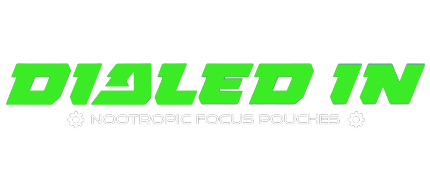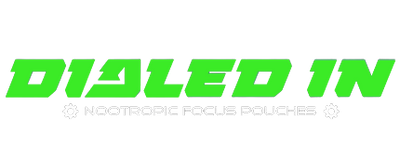How to Achieve Flow and Unlock Peak Performance
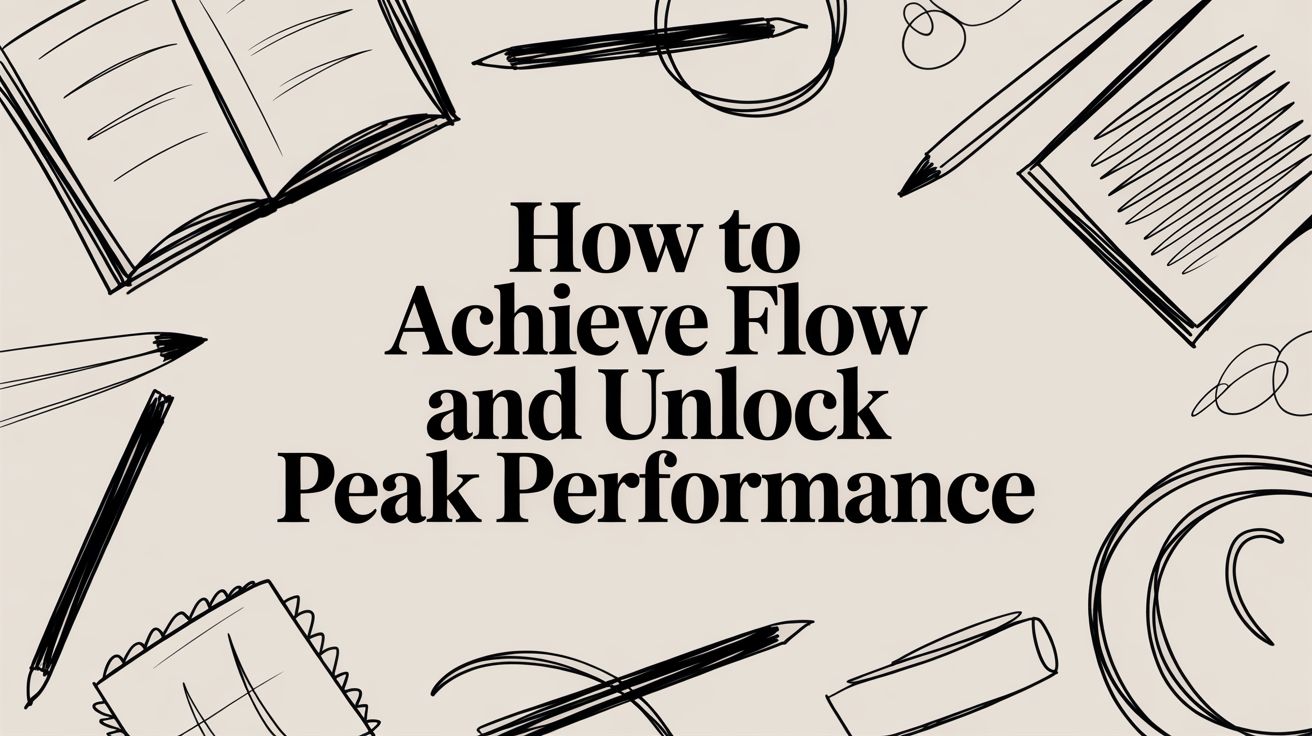
Getting into a flow state isn't some mystical event that happens by chance. It's a skill you can build. It all comes down to creating the right conditions for deep immersion by getting three key elements in sync: your environment, your mindset, and your physical readiness. When these align, you can tap into peak performance pretty much on command.
What It Really Means to Be in Flow
Ever get so lost in something that hours just melt away? That's flow. Psychologist Mihaly Csikszentmihalyi coined the term to describe that perfect state of optimal experience where you feel your best and perform your best.
It’s that feeling of effortless concentration where the outside world just disappears, leaving only you and the task at hand. Your focus is razor-sharp, creativity is firing on all cylinders, and productivity feels totally natural.
This guide is your roadmap to making that state a regular part of your life. We're going to skip the abstract theories and get straight to the practical foundation, built on three core pillars that work together to get you into flow, consistently.
- Your Environment: This is all about designing your physical and digital spaces to shut out distractions. It’s about sending a clear signal to your brain that it’s time for deep work.
- Your Mindset: This is the internal game. We're talking about cultivating the mental triggers for flow, like setting crystal-clear goals and hitting that sweet spot between a task being too hard and too easy.
- Your Physical Readiness: This is the engine. It’s about optimizing your body and brain with the right fuel—proper nutrition, hydration, and targeted support for sustained cognitive horsepower.
This visual map breaks down how these three essential pillars—environment, mindset, and physical readiness—interconnect to create the ideal conditions for flow.
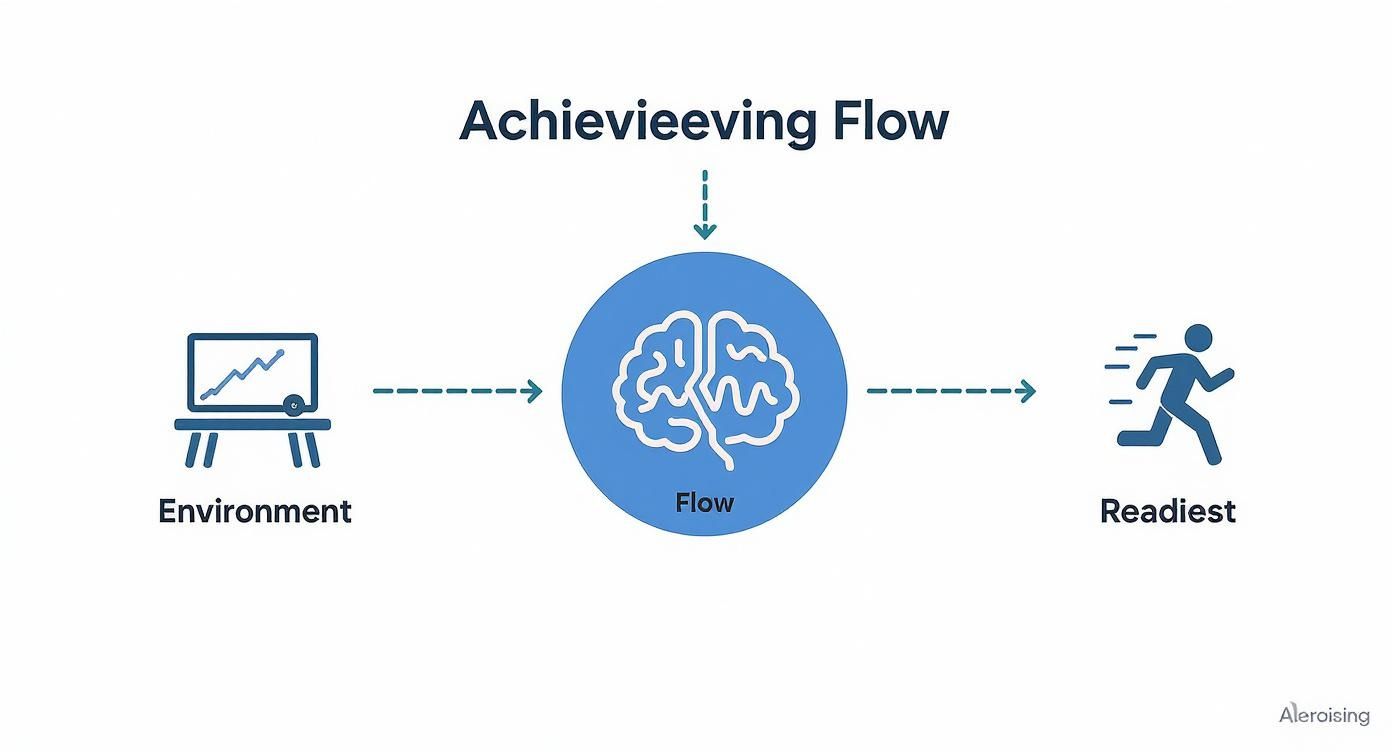
As you can see, flow isn't about one single action. It’s the result of a supportive ecosystem you build for yourself, where each branch represents a crucial area you can control and fine-tune.
To make it even clearer, here's a quick-reference table summarizing the core components.
The Three Pillars of Achieving Flow
| Pillar | Primary Goal | Key Action Example |
|---|---|---|
| Environment | Minimize distractions and create focus triggers. | Turning off phone notifications and using noise-canceling headphones. |
| Mindset | Align challenge with skill and maintain clear objectives. | Breaking a large project into smaller, specific sub-tasks. |
| Physical Readiness | Fuel your brain for sustained cognitive performance. | Staying hydrated and using nootropics for enhanced focus. |
Nailing these three areas is the secret to making flow a deliberate practice rather than a happy accident.
The Power of Physical Readiness
While your environment and mindset are critical, your physical state is the engine that powers sustained concentration. Let's be real—if your brain is running on empty, trying to achieve flow is a massive uphill battle.
This is where strategic support, including the use of nootropics, can be a game-changer. You can learn more about how nootropic pouches are shaping the future of energy and focus in our detailed guide.
By mastering these three domains, you stop hoping for flow to happen by chance and start creating it by design. It's about taking intentional steps to cultivate a state where your best work becomes your default.
Engineer Your Environment for Deep Focus
Your workspace is either your greatest ally or your biggest enemy in the quest for flow. Think about it—your environment sends constant signals to your brain. A cluttered, noisy space screams "distraction," while a clean, quiet one tells your brain it's time for deep work.
To get into flow reliably, you have to be intentional about designing your physical and digital worlds. This isn't just about tidying up. It's about creating what developers call a "focus bubble"—a space where interruptions are systematically shut out and deep concentration becomes the default.
Crafting Your Digital Sanctuary
Digital distractions are the sneakiest thieves of focus. One little notification can completely derail a productive session, pulling you right out of that deep mental state you worked so hard to get into. The key is to get ruthless with digital minimalism when it's time to perform.
- App Blockers That Actually Work: Use tools like Freedom or Cold Turkey to block distracting websites and apps across all your devices. This isn't about willpower; it's about removing the temptation entirely.
- A Clean Desktop: A desktop covered in icons is a visual to-do list that’s always nagging you. Keep it clean with only the essentials, or better yet, create a specific "work" user profile with zero clutter.
- Embrace Single-Tasking Mode: Resist the urge to keep a dozen tabs open. Full-screen your main application to visually push everything else out of your periphery. This simple move tells your brain, "This is the only thing that matters right now."
By curating your digital world, you create a sterile environment where the task at hand is the only thing competing for your attention. Mastering this is a huge part of learning how to increase focus at work and reclaiming your day.
Optimizing Your Physical Workspace
Your physical surroundings are just as critical. Discomfort, bad lighting, or a sudden noise can easily shatter your concentration and keep you from ever reaching a flow state.
An ergonomic setup is non-negotiable. A chair that supports your back and a monitor at eye level prevent the physical strain that drains your mental energy. You’d be surprised how much these small tweaks can help you stay locked in for hours.
Lighting also plays a surprisingly big role. Natural light is always best, but if that’s not an option, go for cool-toned lighting (around 4000K-5000K). It's proven to promote alertness and concentration way more effectively than warm, cozy light.
Creating a 'focus bubble' isn’t about building a fortress. It’s about strategically curating sensory inputs to guide your brain toward deep, uninterrupted work, making flow an almost inevitable outcome.
Finally, take control of your soundscape. For some, total silence is golden. For others, the right kind of ambient sound is the secret trigger for focus.
- Noise-Cancelling Headphones: This is the most direct way to kill auditory distractions. Instantly create your own personal zone of silence.
- Ambient Sound Generators: Tools that play white noise, brown noise, or nature sounds are fantastic for masking jarring background noises and helping your brain settle into a steady rhythm.
These environmental tweaks are fundamental for anyone serious about sharpening their concentration. Students face their own unique focus battles, but many of these same principles apply. You can find more targeted advice in our guide on how to focus while studying.
Find Your Challenge and Skill Sweet Spot
Flow isn't something that just happens by accident. You trigger it. And one of the most reliable triggers is hitting that perfect balance between how hard a task is and how good you are at it.
Think about playing a video game. If a level is too easy, you get bored and zone out. If it’s impossibly difficult, you get frustrated, anxious, and want to quit. Flow happens in that razor-thin channel right in the middle.
This sweet spot is where a task demands your complete attention but isn't so tough that it feels overwhelming. Learning to actively seek out this balance in your work is a core skill for getting into flow on demand. It's about reframing what you do to create an environment where deep focus becomes almost inevitable.
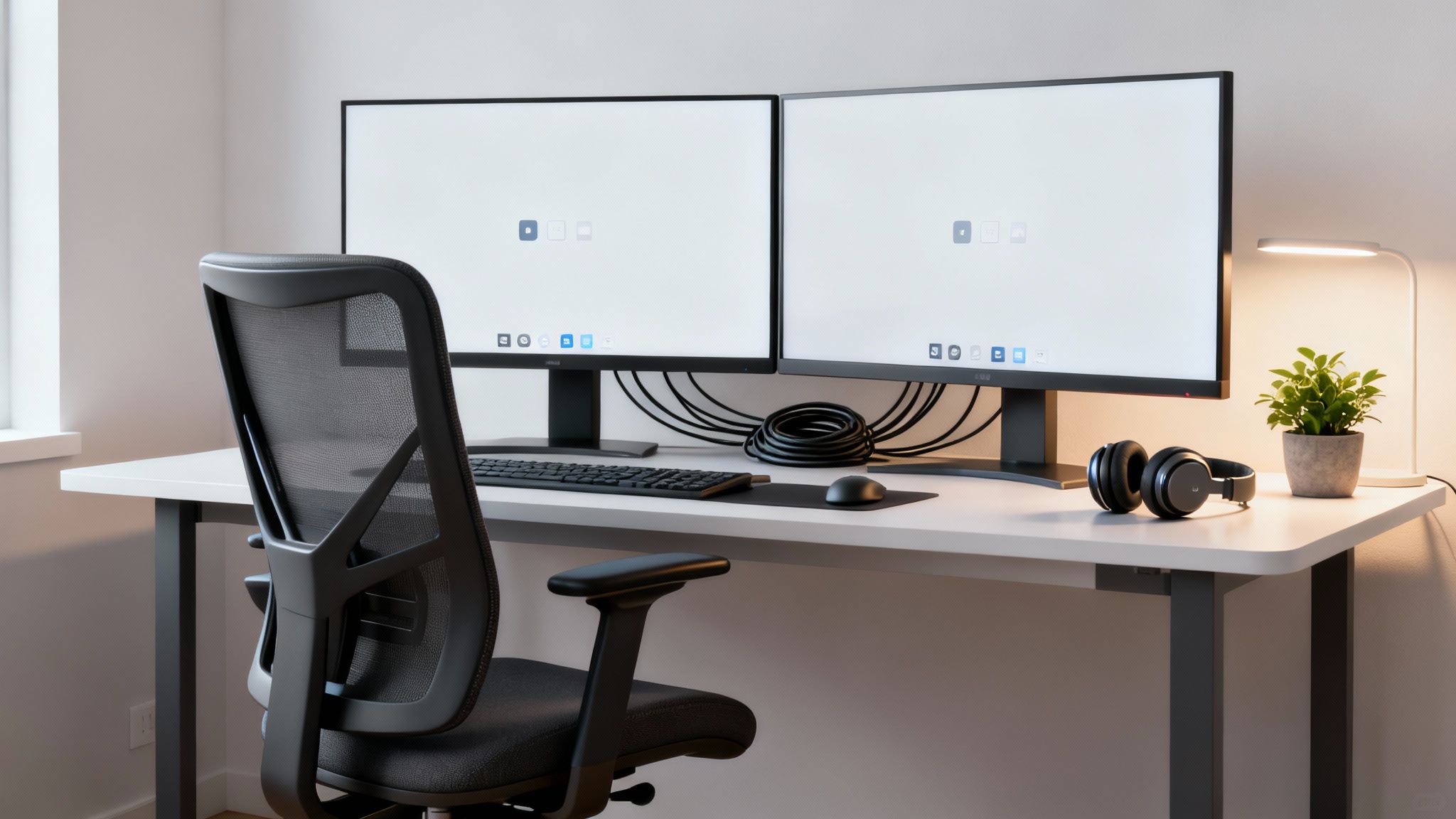
This isn't just a neat productivity trick, either. The implications for professional performance are massive. Research stemming from Mihaly Csikszentmihalyi's work has shown that when employees operate in this zone, their productivity can skyrocket by as much as five times. This state is also tied directly to higher job satisfaction and better overall performance. You can read more about the impact of flow on workplace productivity right here.
Deconstruct Daunting Projects
A massive, vague project is the enemy of flow. A goal like "finish the quarterly report" is way too big and intimidating to start on. The secret is to chop it up into a series of smaller, immediate, and totally manageable micro-goals.
Instead of one giant task, you want a checklist of smaller items that are just challenging enough to keep you engaged.
- Original Goal: Build a new marketing campaign.
-
Deconstructed Goals:
- Research competitor ad copy for 30 minutes.
- Write five headline variations.
- Sketch out one primary visual concept.
- Outline the email sequence.
Each tiny win delivers a small hit of dopamine and builds momentum, pulling you deeper into the work. You’re no longer staring up at a mountain; you're just taking the next logical step on the path.
Create Your Own Feedback Loops
Flow thrives on immediate feedback. You need to know, moment by moment, if what you’re doing is actually working. A coder gets this instantly—the code either compiles or it throws an error. But for most of us, feedback can be delayed for weeks or even months.
When the work itself doesn't provide instant feedback, you have to build it yourself.
Define what "success" looks like for the next hour, not the next quarter. Set a timer and challenge yourself to complete a specific sub-task within that block. This creates a self-contained game with a clear win condition.
For instance, if you're a writer, your feedback loop could be finishing a 250-word section without checking your phone. A designer? Finalize a logo's color palette in 20 minutes. These mini-deadlines provide that immediate sense of progress you need to stay locked in and maintain the delicate balance between challenge and skill.
Fuel Your Brain for Sustained Concentration
Getting your environment and mindset right are massive steps toward flow state, but they’re only half the battle. Your brain is a high-performance engine, and it needs premium fuel to maintain the kind of concentration that deep work demands.
If you’re running on fumes physically, mental clarity will always feel just out of reach.
Proper nutrition isn’t just about general health—it's a direct input for your cognitive function. Your mental stamina is tied directly to what you eat and drink. This means getting past the quick sugar fixes that lead to the inevitable energy crash and focusing on foods that provide stable, long-lasting power for your brain.
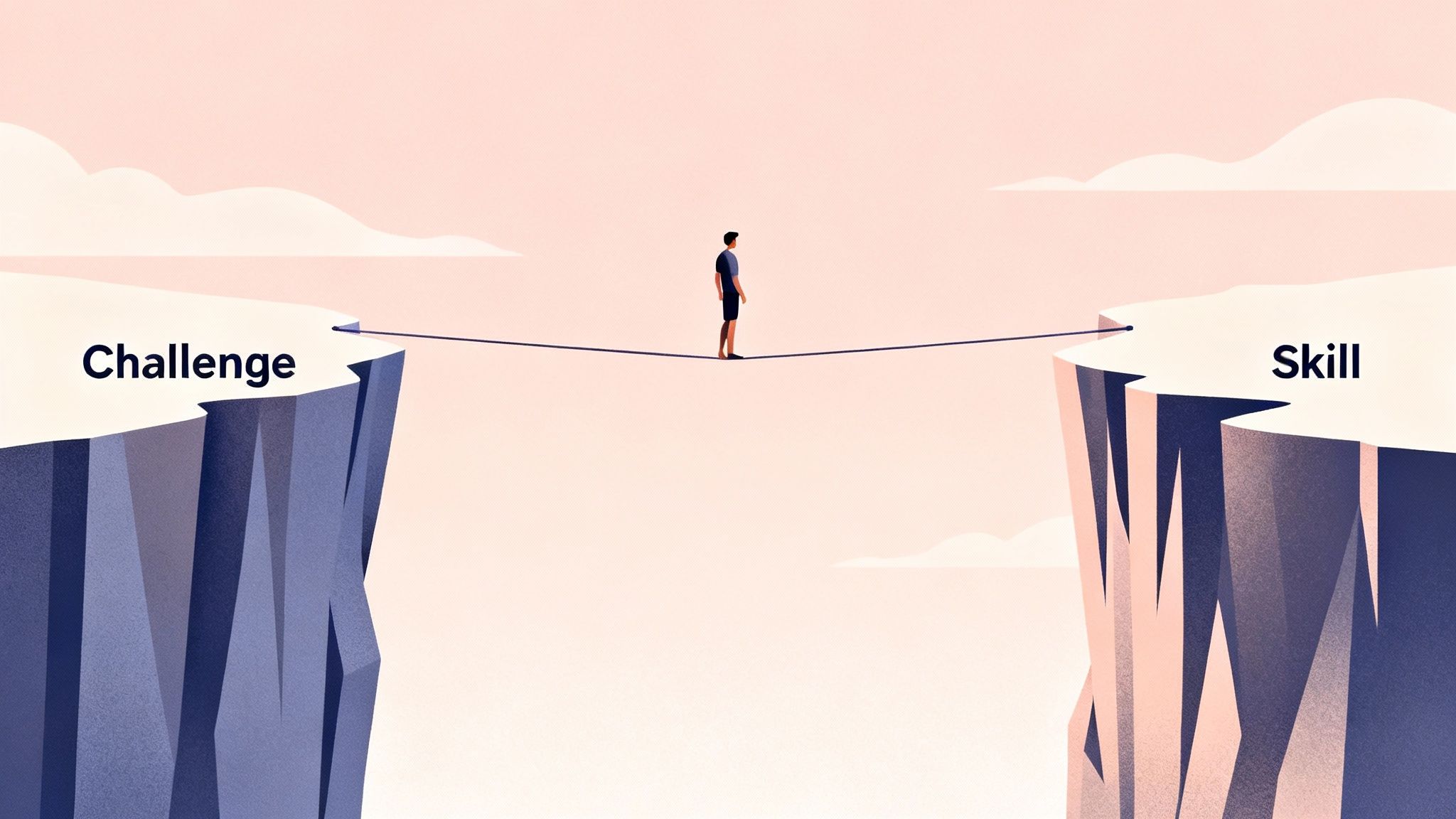
Think of it like preparing for an exam. You wouldn't cram on an empty stomach and expect to perform well. To really optimize your mental input, it helps to understand how to study from textbooks more effectively and remember what you read—a process that also requires serious mental endurance.
Foundational Fuel for Your Brain
Before you even think about supplements, your baseline nutrition and hydration need to be locked in. These are the absolute non-negotiables for getting into flow.
- Complex Carbohydrates: Foods like oats, brown rice, and quinoa give you a slow, steady release of glucose—your brain's main energy source. This prevents the sharp spikes and awful crashes you get from simple sugars.
- Omega-3 Fatty Acids: Found in fatty fish, walnuts, and flaxseeds, these healthy fats are absolutely essential for brain health and can sharpen both focus and memory.
- Hydration: This one is huge. Even mild dehydration—we're talking as little as a 2% loss in body water—can seriously tank cognitive functions like attention and short-term memory. Keep a water bottle within arm's reach. Always.
Your ability to enter a flow state is directly limited by your biological resources. Neglecting nutrition and hydration is like trying to win a race with a sputtering engine—you simply won't have the horsepower to get there.
Introducing Nootropics for an Extra Edge
Once your nutritional base is solid, you can start exploring nootropics. These are compounds specifically designed to support brain function, enhance focus, and build your resilience against mental fatigue.
They work by supporting the brain's natural pathways for alertness and concentration, giving you a clean boost without the jitters. For a deeper dive, check out our complete guide on how to boost your energy and focus.
Key Ingredients That Actually Make a Difference
Not all nootropics are created equal. A few science-backed ingredients are particularly good at creating that calm, alert state you need for true flow.
- L-Theanine & Caffeine: This is the classic stack for a reason. Caffeine provides the raw alertness, while L-Theanine (an amino acid from green tea) smooths out the edges and prevents jitters. The result is a synergistic effect that boosts cognitive performance without the anxiety.
- Bacopa Monnieri: This ancient herb is an adaptogen, which means it helps your body and mind handle stress better. It’s been shown to improve memory and reduce anxiety, making it much easier to stay locked into a task without getting derailed or overwhelmed.
By combining a solid nutritional strategy with targeted nootropic support, you’re giving your brain everything it needs to perform at its peak. Ready to get dialed in? You can purchase our Focus Pouches and Focus Gum directly from our site and feel the difference.
The Real-World Rewards of Finding Flow
Getting into a flow state is about so much more than that fleeting "in the zone" feeling. It delivers real, measurable results that can completely reshape your work and your life.
This deep immersion is where your best performance lives. It’s the engine that drives not just faster work, but better, more creative, and more innovative output.

This isn't just a subjective experience, either. The numbers are staggering. Research shows that employees in a flow state can be up to five times more productive than their peers. That massive boost is tied directly to higher job satisfaction and well-being, because you feel more engaged and in command of your work.
Tapping into this state doesn’t just accelerate timelines; it dramatically improves the quality of what you produce, making it an incredible tool for professional growth.
Beyond Productivity: The Psychological Payoff
The benefits of consistently finding flow stretch far beyond your to-do list. Psychologically, it’s a powerful antidote to modern workplace anxiety and burnout.
When you're truly in flow, your sense of self temporarily fades. That inner critic goes silent, and you're free to act with pure clarity and confidence.
Emerging from a flow state almost always leaves you with a stronger sense of accomplishment and a real boost in self-esteem. You didn’t just finish a hard task—you conquered it at your absolute peak.
By repeatedly engaging in activities that produce flow, you're not just getting things done; you are actively building a more resilient, confident, and purposeful version of yourself. This is the ultimate motivation for learning how to achieve flow.
A Stronger Sense of Purpose
Beyond individual tasks, regular flow experiences build a greater sense of meaning in your life. By mastering challenges and sharpening your skills, you create a positive feedback loop that reinforces your competence and purpose.
This is a deep satisfaction that passive entertainment or easy tasks can never touch.
This pursuit of mastery is a core part of a fulfilling life. When you consistently tap into this state, you're not just checking boxes—you're crafting a more engaged and meaningful existence, one focused session at a time. It also helps sustain your energy for the long haul, reducing your reliance on quick fixes.
For those looking to optimize their energy without the jitters, exploring natural alternatives to caffeine can be a great complementary strategy. Ultimately, the rewards of flow are both immediate and enduring, impacting your output and your outlook.
Common Questions About Finding Your Flow
Even when you have a solid plan, trying to hit flow state consistently is going to come with some real-world friction. Roadblocks are totally normal. The key is learning how to troubleshoot them on the fly—that's what separates those who get into deep work occasionally from those who can do it reliably.
This is your practical guide for getting back on track when you feel stuck. We'll cover the most common hurdles people run into and give you clear, actionable answers to keep you moving.
What If I Keep Getting Interrupted?
Let's be real: unavoidable interruptions are a part of life. But they don't have to completely torpedo your focus session. It all comes down to how you re-engage with your task afterward.
- Create a "Re-entry" Note: Before you turn your attention to the distraction, quickly jot down the very next physical action you need to take. Don't write something vague like "finish report." Get specific: "review Q3 sales data on line 42." This tiny step makes jumping back in almost effortless.
- Use a Recovery Ritual: Develop a quick, 30-second ritual to reset. It could be as simple as closing your eyes and taking three deep breaths, or re-reading the last paragraph you wrote. This small act signals to your brain that it's time to get back in the zone.
This proactive approach cuts down the mental energy needed to restart, making it much easier to slip back into a state of concentration once the interruption is handled.
Why Can't I Find Flow Today?
Some days, flow just feels out of reach. Forcing it usually just makes things worse. This is almost always a sign that one of your core pillars—your environment, mindset, or physical state—is out of alignment.
First, run a quick diagnostic check. Is your environment truly free of distractions? Is the task at hand too easy (leading to boredom) or too difficult (causing anxiety)? Did you get enough sleep, and have you fueled your body properly? Often, a small tweak in one of these areas is all it takes to unlock the door to flow.
If you’ve checked all the boxes and still feel blocked, the best move might be to simply step away. Take a short walk, switch to a low-effort administrative task, or just take a real break. Trying to brute-force focus when your brain isn't cooperating is a recipe for burnout.
Sometimes the problem feels more persistent. If you find yourself constantly struggling, you might have specific questions about our products or how they can fit into your focus routine. For direct answers, check out our detailed frequently asked questions page for more information.
Ready to stop hoping for focus and start creating it? Dialed In Nootropics offers chewable Focus Gum and discreet Focus Pouches designed to sharpen your attention and maintain steady energy without the crash. Give your brain the fuel it needs for peak performance. Get dialed in today.
